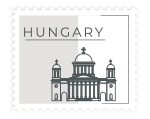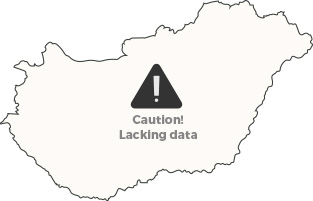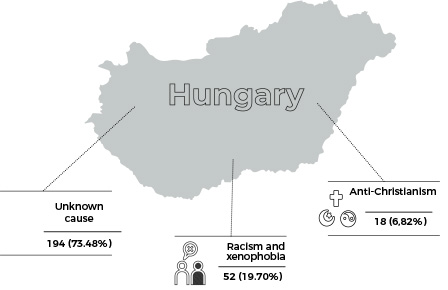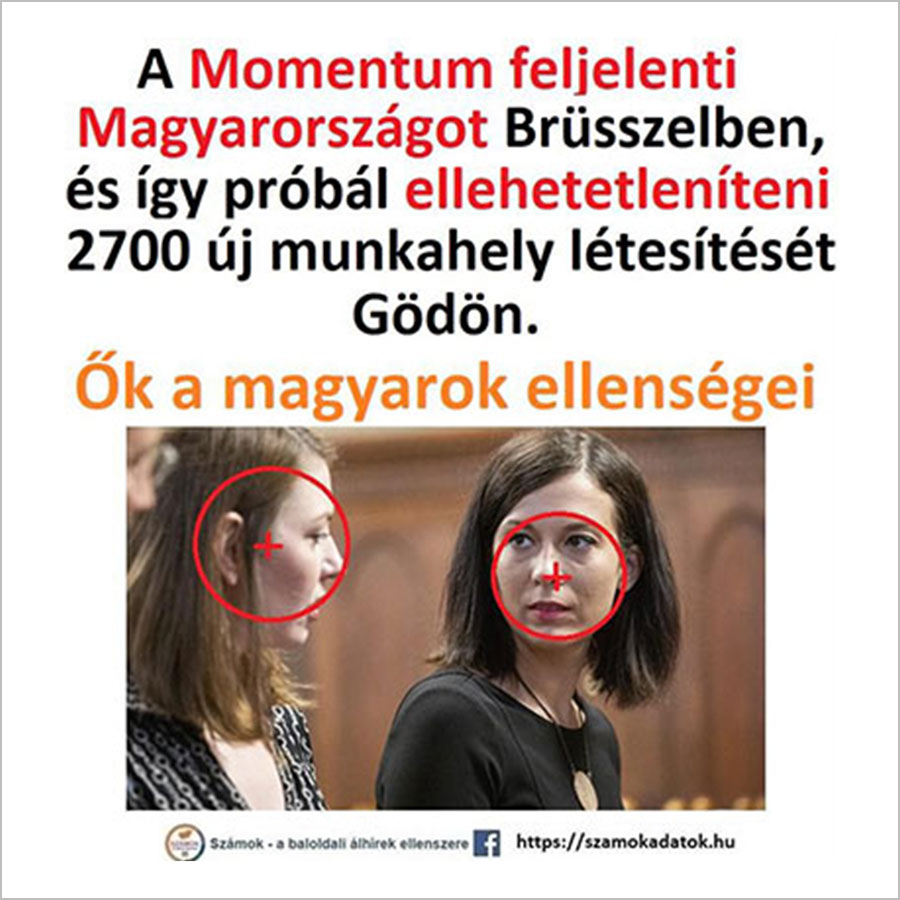Hungary

9.769.526
population
Official Data
264
Total hate crimes
Motivations with the highest number of hate crimes
 |
Unknown cause |
| 194 (73,48%) |
 |
Racism and xenophobia |
| 52 (19,70%) |
 |
By religion |
| 18 (6,82%) |
Chronology of offences reported by the OSCE
Total 264
Civil society data
137
Total hate crimes
Motivations with the highest number of hate crimes
 |
Anti-Semitism |
| 81 (59,12%) |
 |
Racism and xenophobia |
| 35 (25,55%) |
 |
Anti-Gypsyism |
| 7 (5,11%) |
crimes

59.12% anti-Semitic crimes

No data quality, lack of observatories
Own data
Identified mortal victims
Official data
Casualties in incidents resulting in death and injury
Civil society data
Mortal victims

Caution!
Lacking data

| — men |
| — women |
| — transgender/transexual |
| — not identified |
Official data
OSCE. The existing OSCE data on hate crimes in Hungary* is clearly underrepresented and deficient. According to these figures, a total of 264 hate crimes have taken place in Hungary from 2015 to 2018, which represents 0.82% of the total number of hate crimes in Hungary, based on data from official sources.
Of the 264 offences, 194 relate to the year 2018 and are collected in an unspecified category as the motivation of the hate crime is not indicated. Fifty-two offences belong to the category of attacks motivated by racism and xenophobia and correspond to the year 2017. This year also includes 18 offences of attacks against members of other religions. The other categories do not contain any further data.
These 18 offences from Hungary in 2017 are in this category because they come from the “Police Data”, i.e. the source of the data is the OSCE and it was transferred with the available information indicated. There is no way of knowing against which “other” religions those attacked were perpetrated.
The systematic policy of concealment of data by Viktor Orbán’s government, in its nationalist identity logic that Hungarian society, thanks to his government, does not suffer from discrimination or hatred, while at the same time blaming all problems on foreigners and immigrants, is manifest.
Prime Minister Viktor Orbán called it a “provocation” that the Irish national football team knelt against racism before the friendly match against Hungary in Budapest, a gesture to which the local crowd reacted with boos.
Chronology of crimes reported by the OSCE
Total 264
![]() The absence of data on hate crimes in Poland and Hungary is symptomatic of the lack of control over the data.
The absence of data on hate crimes in Poland and Hungary is symptomatic of the lack of control over the data.
Figure 41: Map of Hungary with total number of hate incidents and motivations with highest percentages
- Racism
- Anti-Christianism and other religions
- Unkown cause
Figure 42: Evolution of official data on hate incidents in Hungary, 2015-2018

Figure 43: Total crime in Hungary according to OSCE data by motivation, 2015-June 2020
Civil society data
Hungarian civil society organisations recognised by the OSCE for their reports count 137 registered cases of hate crimes. This low number seems to correspond to the lack of well-structured civil society organisations with sufficient logistical capacities to carry out systematic data collection.
From the data collected, the two motives that account for almost 75% of the cases are anti-Semitic crimes, 81 (59.12%), and those motivated by racism and xenophobia, 35 (25.5%). Behind and with an equal percentage come those motivated by anti-Gypsy and against sexual orientation with 7 crimes (5.11%) each.
Islamophobic crimes (3) represent 2.19%, the rest of the motivations being almost nil (political intolerance 1 -0.73%) or showing no data at all (attacks against disabled persons or attacks against members of other religions).
Amnesty International has repeatedly denounced human rights conditions in Hungary. It has gone so far as to denounce that the Hungarian public media censor its press releases on ideological grounds.
AI’s latest report notes that Parliament banned legal recognition of the gender identity of intersex and transgender people in 2020, and made it mandatory to register birth sex, based on biological markers and chromosomes, without the possibility of changing it later. For transgender people, this meant that they would no longer be able to change it on certificates and official documents to reflect their gender identity.

Caution!
Lacking data
The European Court of Human Rights ruled that Hungary had violated an Iranian transgender man’s right to respect for his private and family life. He had been granted refugee status in Hungary on the grounds that he suffered persecution because of his gender identity, but the authorities had refused to legally recognise his name and gender.
In December 2020, Parliament passed a law denying adoption rights to LGBTI persons, along with a discriminatory amendment to the Constitution to specify that “the mother is female and the father is male” and that Hungary “protects the self-identity of children on the basis of their birth sex”.
The next step was the passing of a law prohibiting homophobic talk in schools, thus depriving all young people of information about sexuality and recognition of their condition.
The strategy of anti-LGBT intolerance is masked in Hungary by the government as a mere ideological confrontation. It is also a way of masking homophobic rhetoric from power.
![]() The absence of data on hate crimes in Poland and Hungary is symptomatic of the lack of control over the data.
The absence of data on hate crimes in Poland and Hungary is symptomatic of the lack of control over the data.
Table 17: Annual trend of hate incidents in Hungary by type of motivation, 2015-June 2020
* Data for the first six months of 2020
| HUNGARY | TOTAL | Total (%) | 2015 | 2016 | 2017 | 2018 | 2019 | 2020* |
|---|---|---|---|---|---|---|---|---|
| Anti-Semitism | 81 | 59,12% | 28 | 8 | 10 | 12 | 23 | -- |
| Racism and xenophobia | 35 | 25,55% | 10 | 4 | 12 | 9 | -- | -- |
| Anti-Gypsyism | 7 | 5,11% | 2 | -- | 4 | 1 | -- | -- |
| Crimes against sexual orientation | 7 | 5,11% | 2 | 2 | 3 | -- | -- | -- |
| Anti-Christianism and other religions | 3 | 2,19% | -- | 1 | 1 | 1 | -- | -- |
| Islamophobia | 3 | 2,19% | -- | -- | -- | 2 | 1 | -- |
| Political intolerance | 1 | 0,73% | -- | -- | -- | -- | -- | 1 |
| TOTAL | 137 | -- | 42 | 15 | 30 | 25 | 24 | 1 |
Figure 44: Annual incidents in Hungary by type of motivation. Civil Society Data
| TOTAL 1.362 | 2015 | 2016 | 2017 | 2018 | 2019 | 2020 | |
|---|---|---|---|---|---|---|---|
 | Anti-Semitism | ||||||
| 767(47,14%) | 28 | 8 | 10 | 12 | 23 | ||
 | Racism and xenophobia | ||||||
| 221 (13,58%) | 10 | 4 | 12 | 9 | |||
| Anti-Gypsyism | |||||||
| 2 (0,12%) | 2 | 4 | 1 | ||||
 | Crimes against sexual orientation | ||||||
| 60 (3,69%) | 2 | 2 | 3 | ||||
 | Anti-Christianism and other religions | ||||||
| 500 (30,73%) | 1 | 1 | 1 | ||||
 | Islamophobia | ||||||
| 48 (2,95%) | 2 | 1 | |||||
 | Political intolerance | ||||||
| 17 (1,04%) | 1 |
Figure 44: Annual incidents in Hungary by type of motivation. Civil Society Data
| TOTAL 1.362 | 2015 | 2016 | 2017 | 2018 | 2019 | 2020 | |
|---|---|---|---|---|---|---|---|
 | Anti-Semitism | ||||||
| 767(47,14%) | 28 | 8 | 10 | 12 | 23 | ||
 | Racism and xenophobia | ||||||
| 221 (13,58%) | 10 | 4 | 12 | 9 | |||
| Anti-Gypsyism | |||||||
| 2 (0,12%) | 2 | 4 | 1 | ||||
 | Crimes against sexual orientation | ||||||
| 60 (3,69%) | 2 | 2 | 3 | ||||
 | Anti-Christianism and other religions | ||||||
| 500 (30,73%) | 1 | 1 | 1 | ||||
 | Islamophobia | ||||||
| 48 (2,95%) | 2 | 1 | |||||
 | Political intolerance | ||||||
| 17 (1,04%) | 1 |
Cases
Neo-Nazi march in Budapes. Several hundred German neo-Nazis took part in the fascist “Day of Honour” in Budapest. With swastikas, SS runes and the eponymous symbol of the Hungarian Arrow Cross, which collaborated with Bulgarians with Nazi Germany, some 3,000 demonstrators moved through the Hungarian capital. Speeches and slogans included anti-Jewish messages, and Dortmund neo-Nazi Matthias Deyda concluded his speech with a quote from Adolf Hitler.
The far-right demonstrators, some of whom wore historical uniforms of the fascist armies, referred to the Battle of Budapest in the winter of 1945.
Since 1997, neo-Nazis commemorated this event in Budapest. In 2003, the Hungarian branch of the “Blood and Honour” network, banned in Germany, took over the organisation. According to Professor Magdalena Marsovszky, the commemoration day was introduced into the official remembrance policy through Viktor Orbán’s government, and in the present it influences the whole of Hungary in terms of cultural policy. In recent years, various events have always been held, including those organised by the regional administration of the ruling Fidesz party.
In addition to the collaboration of Hungarian governments with the Nazis before 1944, which led to the murder of some 60,000 Jews and laws that stripped them of their citizenship, after the German occupation in March 1944, in just 56 days, 424,000 Hungarian Jews were sent to extermination camps. With the arrival of the Hungarian Arrow Cross in power in October 1944, further massacres culminated on the banks of the Danube where the corpses were dumped.
An estimated 565,000 Hungarian Jews out of 800,000 were murdered.
Following the demonstrations in February 2019, Hungarian and European Jewish representatives expressed their fear and that neither the police nor the authorities did anything to prevent or stop the humiliating and whitewashing march echoing the mass murder out of prejudice and hatred. They criticised the hypocrisy of a government that claims to want to protect the Hungarian Jewish community.
https://elpais.com/internacional/2018/11/03/mundo_global/1541237325_465149.html
Hungarian MEPs Anna Julia Donath and Katalin Cseh are explicitly threatened on a social network. The two Hungarian MEPs belonging to the Hungarian party “Momentum Movement” were subjected to harassment and threats when a photo of them was posted with targets on their faces. The photo was posted on a profile that includes supporters of Viktor Orban, the Hungarian president.

Threats on Facebook against two Hungarian MEPss

